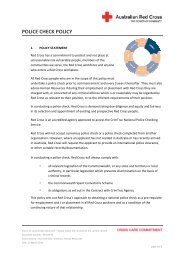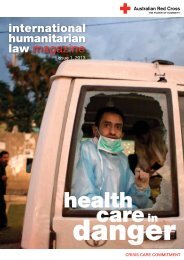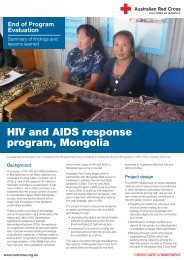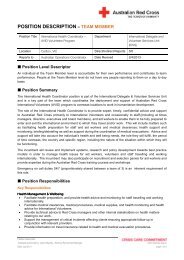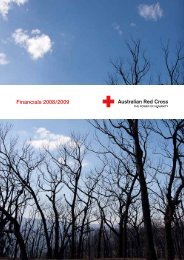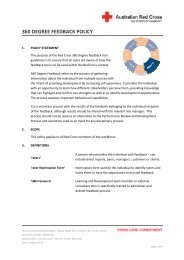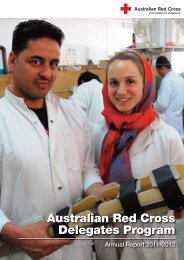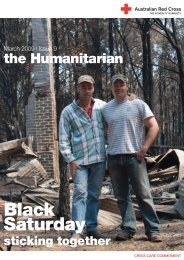Humanitarian - Australian Red Cross
Humanitarian - Australian Red Cross
Humanitarian - Australian Red Cross
You also want an ePaper? Increase the reach of your titles
YUMPU automatically turns print PDFs into web optimized ePapers that Google loves.
Kimie Yamada visits the apartment building where she once lived with her two<br />
young daughters. Their apartment was destroyed by the tsunami. Photo: IFRC<br />
Devastation in Japan<br />
On 11 March, one of the<br />
largest earthquakes and<br />
most powerful tsunamis<br />
in recent history wiped<br />
out towns and villages<br />
in north-east Japan.<br />
The largest wave reached approximately<br />
38 metres high. More than 27,000<br />
people were killed or are missing and<br />
thousands more were injured.<br />
Many affected residents like Kimie<br />
Yamada are struggling to make sense of<br />
the devastation, yet there is still a strong<br />
will to rebuild their communities.<br />
Kimie Yamada points at the small<br />
apartment building that just last month<br />
she shared with her two daughters.<br />
Today, like many other structures in<br />
Rikuzentakata, only the shell remains<br />
following the tsunami that swept<br />
through it on 11 March. This coastal<br />
city of 30,000 people was decimated<br />
by the tsunami. The only signs of<br />
houses that once neighboured Kimie’s<br />
apartment building are the foundations<br />
they once stood on.<br />
Since that day, Kimie and her<br />
daughters have been living with her<br />
parents. It’s crowded and Kimie feels<br />
she is burdening them, but that is<br />
about to change. The family has been<br />
selected as one of the first to receive a<br />
newly built pre-fabricated house. The<br />
government is constructing 70,000<br />
of them across the three hardesthit<br />
prefectures of Iwate, Miyagi and<br />
Fukushima. The Japanese <strong>Red</strong> <strong>Cross</strong><br />
Society, using funds donated from<br />
overseas, is fitting each of these prefabricated<br />
houses with a package<br />
of six appliances, a project that will<br />
benefit more than 280,000 people.<br />
‘We have been receiving donations<br />
from other <strong>Red</strong> <strong>Cross</strong> and <strong>Red</strong><br />
Crescent societies around the world,’<br />
says Atsuhiko Hata, the Japanese<br />
<strong>Red</strong> <strong>Cross</strong> Society’s public relations<br />
director. ‘We wanted to use these<br />
donations to meet the needs of<br />
tsunami survivors. The six appliances<br />
we are providing are the bare minimum<br />
needed to help them start a new life.’<br />
The appliance package includes<br />
a refrigerator, washing machine,<br />
microwave, rice cooker, hot water<br />
dispenser, and a television; items that<br />
help make a house a home, and, in the<br />
case of the television, a valuable tool<br />
for providing information before, during<br />
and after disasters.<br />
A life-changing disaster<br />
A senior international <strong>Red</strong> <strong>Cross</strong> team<br />
undertook a successful assignment<br />
in Japan, not long after the tsunami.<br />
They were assisting Japanese <strong>Red</strong><br />
<strong>Cross</strong> to develop a comprehensive<br />
plan for the response.<br />
When Head of International<br />
Programs at <strong>Australian</strong> <strong>Red</strong> <strong>Cross</strong>,<br />
Donna McSkimming, arrived at the<br />
earthquake area, the devastation was<br />
shocking. ‘Essentially the scenes that<br />
we saw were just piles of tsunami<br />
debris that were bits of houses,<br />
reduced to splinters. Cars were just<br />
tossed around like toys hanging off<br />
fences and buildings,’ Donna says.<br />
The Japanese response was impressive<br />
says Donna. ‘It was incomprehensible to<br />
imagine how the devastation could be<br />
cleaned up and restored yet everywhere<br />
we went we saw evidence of that.’<br />
Schools are being opened and <strong>Red</strong><br />
<strong>Cross</strong> is working towards restoring<br />
normal life for the hundreds of thousands<br />
of people affected.<br />
There is still a terrible tragedy of the more<br />
than 12,000 people who are still missing,<br />
Donna says. ‘In order to bring some<br />
comfort and surety to the family, it is very<br />
important to find out as much as we can<br />
about individuals not yet accounted for.’<br />
The <strong>Australian</strong> fundraising effort has<br />
been inspiring for Japanese people,<br />
Donna adds with a smile. ‘This is the<br />
worst disaster to hit Japan since World<br />
War II. And as one of my Japanese<br />
colleagues said, “it will change<br />
us forever in ways we can’t even<br />
anticipate at this point in time”.’<br />
How you can help<br />
The New Zealand Earthquake Appeal<br />
2011, run by <strong>Australian</strong> <strong>Red</strong> <strong>Cross</strong><br />
is now closed. You can continue to<br />
support our work by donating to our<br />
ongoing Disaster Relief and Recovery<br />
work in Australia. To make a donation,<br />
visit www.redcross.org.au or call<br />
1800 811 700.<br />
– Kathy Mueller, IFRC<br />
Page 08






